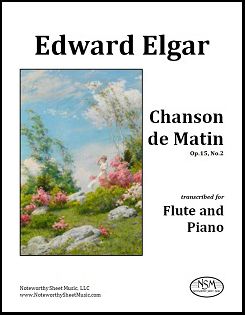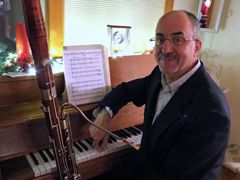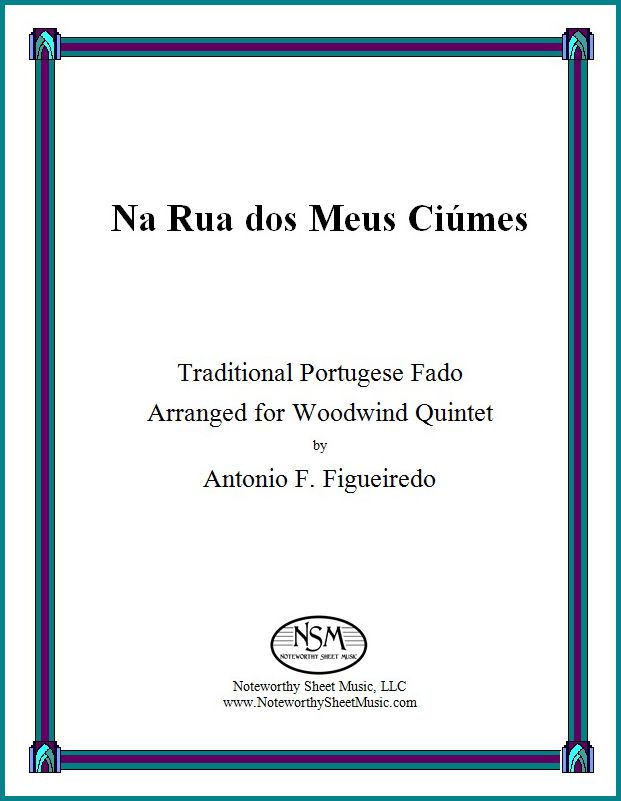flute
All scores that include a part for at least one flute.
Dieter - The Golden “Reade” Flute - Flute & Piano
 The Golden "Reade" Flute, by Eugene A. Dieter
The Golden "Reade" Flute, by Eugene A. Dieter
Flute Part and Piano Score ― PDF $7.99
Elmer Reade (1898-1986), to whom The Golden "Reade" Flute is dedicated, served a long and distinguished career, first as a flutist with the U.S. Army Band and then as a conductor and music director of the Air Force Band at Mitchell Field, New York. Eugene A. Dieter graduated from the first class of the US Army Music School in 1941 and was appointed a bandmaster. Following the Second World War, Dieter accepted a bandmaster position with the Air Force Band and remained active until his retirement in 1966. Likely, it was as an Air Force band colleague of Elmer Reade's that Dieter was inspired to compose The Golden "Reade" Flute. (excerpted from the foreword © by P. H. Bloom)
Not at all militaristic in character, The Golden "Reade" Flute is more a lovely barcarole, a single Andante moderato movement in 6/8 time. It offers interesting writing for both parts, so flutist and pianist will be equally pleased. The title refers to the gold flute by William S. Haynes upon which Reade regularly performed.
Piano score, 4 pages; Flute part, 2 pages.
PreviewDressler - Portrait Charmant - Flute (or Vn) & Piano
 Portrait Charmant, by Raphael Dressler
Portrait Charmant, by Raphael Dressler
Gassett Collection - Facsimile Edition by C.A.Vater/Noteworthy Sheet Music
Part for Flute or Violin and Piano Score, PDF $3.00
Raphael Dressler (1784-1835) was a well-known Austrian flutist and composer. He wrote more than 100 compositions for flute and published a popular flute method book, New and Complete Instructions for the Flute. His career included a position as first flutist in the Kärntnerthor Theater orchestra in Vienna and many years as a teacher and performer in London. Dressler's Portrait Charmant is the fifth of his Douze Thèmes Favoris pour Pianoforte et Flûte (ou Violon). The piece is a short work, simple yet indeed charming, and playable by flutists (or violinists) and pianists of many skill levels. A favorite of ours, Portrait Charmant can also be played effectively as a solo work for flute or violin alone.
For additional information about the Gassett Collection, please see see our article An Introduction to the Gassett Collection.
Piano score, 3 pages; Flute or Violin part, 1 page; Total, 8 pages.
PreviewDrouet - Salute to New York - Flute and Piano
 Salute to New York, A Song for the Flute, by Louis Drouet
Salute to New York, A Song for the Flute, by Louis Drouet
Edited and with a Foreword by P. H. Bloom
Piano Score and Flute Part, PDF $5.99
We have posted Peter H. Bloom's fascinating and highly informative © foreword to this edition, in its entirety, elsewhere on our website, under Resources - Reviews & Articles, so please visit that page for additional historical details regarding the composer, Salute to New York, the New York Crystal Palace, and Hall & Son's flutes, beyond the short excerpts and paraphrases included here.
Louis-Francois-Philippe Drouet (1792-1873) is one of the most highly esteemed flute virtuosi in history. Innumerable contemporary press accounts of his concert triumphs throughout Europe attest to his technical brilliance and exquisite musicianship. He was a prolific and accomplished composer, author, flute theoretician, and pedagogue. His many etudes are still prescribed as tools for flute mastery. His Method of Flute Playing (1830) and 72 Studies on Style and Taste (1855) provide us with useful information concerning instrumental technique and performance practice in the mid-nineteenth century.
The exquisite Salute to New York, A Song for the Flute was performed by Mr. Drouet at the Crystal Palace in New York, on the occasion of its grand reopening under the new management of showman P. T. Barnum in 1854. Our renotated edition of the piece was edited by flutist Peter H. Bloom, who also has enhanced the original piano score with the addition of chord changes in order to broaden the scope of potential players.
Score, 4 pages; Flute part, 2 pages; Total, 14 pages.
PreviewDvořák - Romance, Op. 11 - arr. for Flute Choir
 Romance, Op. 11 by Antonín Dvořák
Romance, Op. 11 by Antonín Dvořák
Arranged for Solo Flute and Flute Choir by C. A. Vater (originally for solo violin and orchestra)
Score and Parts for Solo Concert Flute, 4 Concert Flutes, 2 Alto Flutes, 2 Bass Flutes, and 1 Contrabass Flute, PDF $21.97
Czech composer Antonín Dvořák based his Romance, Opus 11 on the slow movement of his String Quartet in F minor, composed in 1873, re-working that Andante con moto quasi allegretto to create two versions of the Romance, one for solo violin and orchestra (B.39) and another for solo violin and piano (B.38). The Romance is one of Dvořák’s most magnificent melodic works, teaming with romance, lyricism, and emotional intensity. I created a solo flute version of this piece for my personal use, and I so enjoyed playing it that I shared it with a flutist friend / NSM editorial consultant, who suggested that the Romance might be nicely adaptable for flute choir. I took on that challenge and created this arrangement, scored for flute solo with the accompaniment of four concert flutes, two alto flutes, two bass flutes, and one contrabass flute. A few changes have been incorporated in the solo part, bringing the violin’s lowest notes into concert flute range and providing appropriate alternatives to the occasional double stops. Likewise, the various string and wind parts created by Dvořák for his orchestral arrangement (available on IMSLP.org) have been modified in places to suit members of the flute family. Of course, any work played by a flute choir will sound very different than when played by an orchestra, but in arranging this piece for flute choir, every effort has been made to maintain the spirit, character, balance, and flow of Dvořák’s exquisite Romance.
The parts in our edition have been formatted for convenient page turns when the complete PDF is printed 2-sided in its entirety. If a more compact version of the score is desired, however, please select a “2 pages per sheet” printer option for the score and print the score pages separately from the parts.
Score, 60 pages; Solo Flute part, 4 pages of music; Flutes 1-4 parts, each 3 pages of music; Alto Flute 1 part, 4 pages of music; Alto Flute 2 part, 3 pages of music; Contrabass Flute part, 3 pages of music; Total, 104 pages.
PreviewElgar - Chanson de Matin - Fl & Pf
 Chanson de Matin, Op.15, No.2, by Edward Elgar
Chanson de Matin, Op.15, No.2, by Edward Elgar
Transcribed for Flute and Piano by C.A.Vater
Flute Part and Piano Score, PDF $6.99
Edward Elgar composed his Chanson de Matin for violin and piano c.1889-1890. The two companion pieces, Chanson de Matin (No. 2) and Chanson de Nuit (No. 1), together constitute his Op.15, and both pieces were later arranged for small orchestra by the composer. Chanson de Matin was received with great enthusiasm, and its initial and lasting popularity can be attributed largely to its strong melodic appeal. Enduring public affection for the piece has spawned the creation of numerous arrangements and transcriptions, including renditions for cello and piano, viola and piano, flute and guitar, piano solo, organ solo, and string quartet. Noteworthy Sheet Music offers two of our own transcriptions of the lovely Chanson de Matin, one for alto flute and piano and one for concert flute and piano.
Flute part, 2 pages; Piano Score, 4 pages; Total, 12 pages.
PreviewFigueiredo - Na Rua Dos Meus Ciúmes - WW5
 Na Rua dos Meus Ciúmes, Traditional Fado
Na Rua dos Meus Ciúmes, Traditional Fado
Arranged for Woodwind Quintet by Antonio F. Figueiredo
Parts and Score, PDF $10.00
Na Rua Dos Meus Ciúmes is a traditional Portugese fado, still highly popular among recording artists today. This passionate love song tells the story of the intense jealousy experienced by a girl upon seeing her lover pass by with another woman on the street near her home. Though her pain is palpable, the girl is proud and determined to endure her suffering resolutely and without tears.
Antonio Figueiredo was born in the Azores, Portugal, and now resides in Massachusetts. He grew up listening to (and falling in love with) fado music, with all its romance and passion, and its timeless themes of love, loss, jealousy, poverty, and the sea. Figueiredo is a bassoonist who plays regularly in various orchestras and chamber music groups in the Boston area. He enjoys arranging folk tunes for woodwind quintet, and he created this delightful and engaging arrangement of Na Rua Dos Meus Ciúmes for one of his own groups. The piece is scored for flute, oboe, clarinet in B-flat, horn in F, and bassoon.
"This brief piece is a charming addition to the quintet repertory." Read John Ranck's full review of Figueiredo's arrangement of Na Rua Dos Meus Ciúmes.
Score, 5 pages; Parts, 1 page each; Total, 12 pages.
PreviewFinlayson - Moon Shadows - Winds and Percussion
 Moon Shadows, by Walter A. Finlayson
Moon Shadows, by Walter A. Finlayson
Contemporary Composition for 2 Flutes, 2 Clarinets, Bass Clarinet, and 9 Percussion Instruments
Score and Parts, PDF $14.25
Walter Finlayson (1919-2000) was an American composer, musician, educator, and music innovator, with nearly twenty original compositions and some forty arrangements to his credit. While serving in the navy, he played saxophone and clarinet in the US Naval Reserve dance band, seated next to the great Artie Shaw. Finlayson's ASCAP output includes music for band, dance band, orchestra, voice, and chorus. His compositions and arrangements have been published by Boosey & Hawkes, EB Marks, Boston Music, and Mercury Music, and performed by major college marching band programs. One of his best-known compositions is I Had a Premonition, which was written for voice and piano, but which was later arranged for the Jimmie Lunceford Orchestra, one of the preeminent bands of the swing era. A recording of the tune can be heard on The Jimmie Lunceford Collection: 1930-47 compact disc released in 2014 on the Fabulous label, and on YouTube.
Noteworthy Sheet Music's chief editorial consultant Peter H. Bloom received Finlayson's previously-unpublished score for Moon Shadows from the composer's daughter, and we were impressed with its quality and sophistication. For a piece written in the late 1930's or early 1940's, as Gale Finlayson recollects (the score is not dated), Moon Shadows seems remarkably ahead of its time. The work is scored for two flutes, two clarinets, bass clarinet, bells, vibraphone, xylophone, finger cymbals, maracas, bongos, roll cymbals, temple blocks, and tympani. We notated our modern edition of the piece as faithfully as possible based on the hand-written Finlayson score; our edition of Moon Shadows includes both score and parts. We at NSM are pleased to aid in the re-discovery of some of Walter Finlayson's works; for additional information about this interesting composer, please visit the Our Composers page under About Us.
Score, 19 pages; Parts for Flute-1, Flute-2, Clarinet-1, Clarinet-2, Bass Clarinet, Bells, Vibraphone, Xylophone, Finger Cymbals and Maracas, Bongos and Roll Cymbals, Temple Blocks, and Tympani, 1 page each; Total, 34 pages.
PreviewFoster - Old Folks; Oh! Susanna - Vo/Pf/Fl/Vc
 Old Folks at Home and Oh! Susanna, by Stephen Foster
Old Folks at Home and Oh! Susanna, by Stephen Foster
Arranged with Flute and Cello ad lib by John W. Pratt
Flute Parts, Cello Parts, Voice Parts, and Piano Scores ― PDF $7.99
The following excerpts are taken from John W. Pratt's foreword to the edition:When a Golden Oldie comes to mind, Doo-dah! Doo-dah!
Comic, sad, or any kind, Oh! Doo-dah-day!
Jeanie, Swanee, Kentucky, Joe, Doo-dah! Doo-dah!
Beautiful, dreamy, fast, or slow, Oh! Doo-dah-day!
I'll bet I know who wrote it, he wrote them night and day,
Stephen Foster wrote it, he'll never go away.
Stephen Foster was born in Lawrenceville, Pa., on July 4, 1826...He wrote over 200 songs, including 135 parlor songs, 28 minstrel songs, and 21 hymns and Sunday school songs. A remarkable number are memorable, as the ditty above will attest to anyone with anything like my background. One wonders why. The harmonies and rhythms are basic, as are the forms and rhyme schemes (see above), the music is repetitious, and the vocal range rarely goes outside an octave (a great benefit for community singing). Yet the fit is so natural and the pacing so well judged that the songs are ideally effective and diabolically catchy. Foster is perhaps, though on a different plane, the Mozart of his field...
For a pianist playing several stanzas at a sing-along, Foster's songs do become a little dull. But their very simplicity, repetitiousness, and familiarity abet variation as, again on a different plane, chorales serve Bach chorale preludes. Like chorale preludes, the piano parts here always incorporate the melody, so they can be played solo or to accompany amateur singers. It struck me that they could be enhanced by optional flute parts. After writing them, I discovered that, according to his brother Morrison, Foster himself "delighted in playing accompaniments on the flute...As the song went on he would improvise...the most beautiful variations upon its musical theme." If Foster's improvisations were like the one his brother published, however, they just varied the melody itself in the manner of the period. My game is more ambitious, as you will easily see. I added optional cello parts, mostly for color, as in the Haydn trios but superficially more interesting for the cellist. (Again we are on a different plane, of course.)
"Oh! Susanna," one of the best-known American songs by anybody, is Foster's "Erlkönig." (Speak of different planes!) With its nonsensical lyrics and polka beat, it is clearly comical, and I treated it accordingly. It was written in Cincinnati, possibly for a social club, first performed at an ice cream saloon in Pittsburgh in 1847, and published in 1848. When no American song had sold over 5,000 copies, it sold over 100,000. It earned Foster only $100, but its popularity led to a publisher's offer, convincing him to become a professional songwriter, America's first.
"Old Folks at Home" established Foster as a truly American composer. It was written in 1851 for a blackface troupe whose leader paid Foster about $15 to be credited for it. When almost finished, Foster asked his brother for "a good name of two syllables for a Southern river." He rejected Yazoo and Pedee, but was delighted with Swanee, a shortening of Suwanee, a small river in Florida which his brother found in an atlas. Though about a slave's nostalgia for home, I find its theme universal and melancholy and I resisted the temptation to jazz it up. Please try, at least, a slowish tempo.
― John W. Pratt, May 27, 2013 ©
Flute parts, 2 pages; Cello parts, 2 pages; Voice parts, 2 pages; Scores, 7 pages; Total, 18 pages.
PreviewFürstenau - Adagio et Rondo Brillant - Fl & Pf
 Adagio et Rondo Brillant, Op.95, by A. B. Fürstenau
Adagio et Rondo Brillant, Op.95, by A. B. Fürstenau
Gassett Collection - Facsimile Edition by C.A.Vater/Noteworthy Sheet Music with a Foreword by Peter H. Bloom
Flute Part and Piano Score, PDF $12.00
Anton Bernhard Fürstenau (1792-1852) was among the most revered flutists of the 19th century. Following his appointment to the post of principal flute for the Royal Chapel at Dresden in 1820, Fürstenau became a valued colleague and close personal friend of the court's music director, Carl Maria von Weber. The influence of Weber's dramatic melodic gestures and edgy harmonic shifts can be heard in this passionately evocative Adagio et Rondo Brillant. An NSM favorite!
For additional information about the Gassett Collection, please see see our article An Introduction to the Gassett Collection.
Piano score, 12 pages; Flute part, 4 pages; Total, 20 pages.
PreviewGabrielsky - Adagio et Variations - Fl & Pf
 Adagio et Variations pour la Flûte sur un Thême de Caraffa, Op. 71, by W. Gabrielsky
Adagio et Variations pour la Flûte sur un Thême de Caraffa, Op. 71, by W. Gabrielsky
Gassett Collection - New Edition by Noteworthy Sheet Music
Flute Part and Piano Score, PDF $18.75
Johann Wilhelm Gabrielski (or Gabrielsky), 1795-1846, was an acclaimed German flutist and composer from Berlin. In 1814 Gabrielski secured a position as flutist at the theatre in Stettin and within two years was appointed to the Royal Court. Gabrielski's compositions, of which there are more than 100, were highly esteemed and popular in his day. Although these works have much to offer modern day flutists as well, Gabrielski's music is neither widely known nor readily available today. The Adagio et Variations pour la Flûte, Op. 71, exploits melodic material by Michele Enrico Carafa (Caraffa) di Colobrano (1787-1872), a Naples born musician who had a remarkably successful career in Paris as a composer for the Opéra-Comique and as a professor of composition and counterpoint at The Conservatoire. The work showcases the flutist's virtuosity, atop a relatively uncomplicated piano accompaniment.
For additional information about the Gassett Collection, please see see our article An Introduction to the Gassett Collection.
Flute part, 11 pages; Piano Score, 16 pages; Total, 31 pages.
Preview